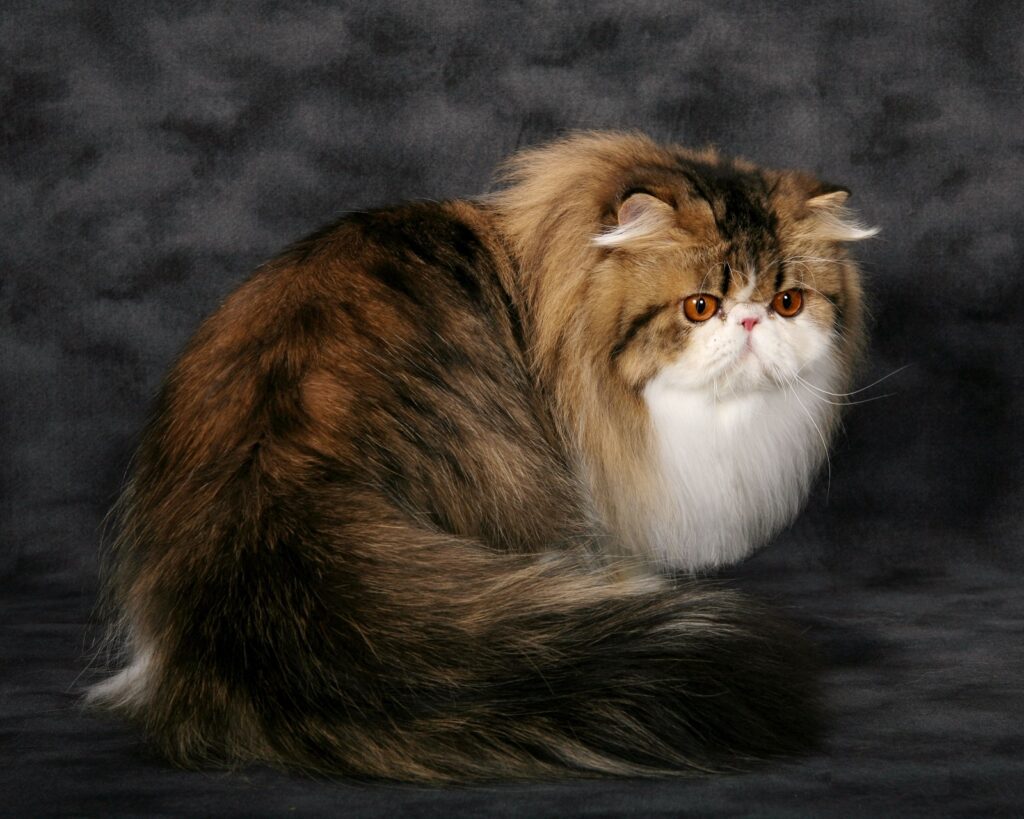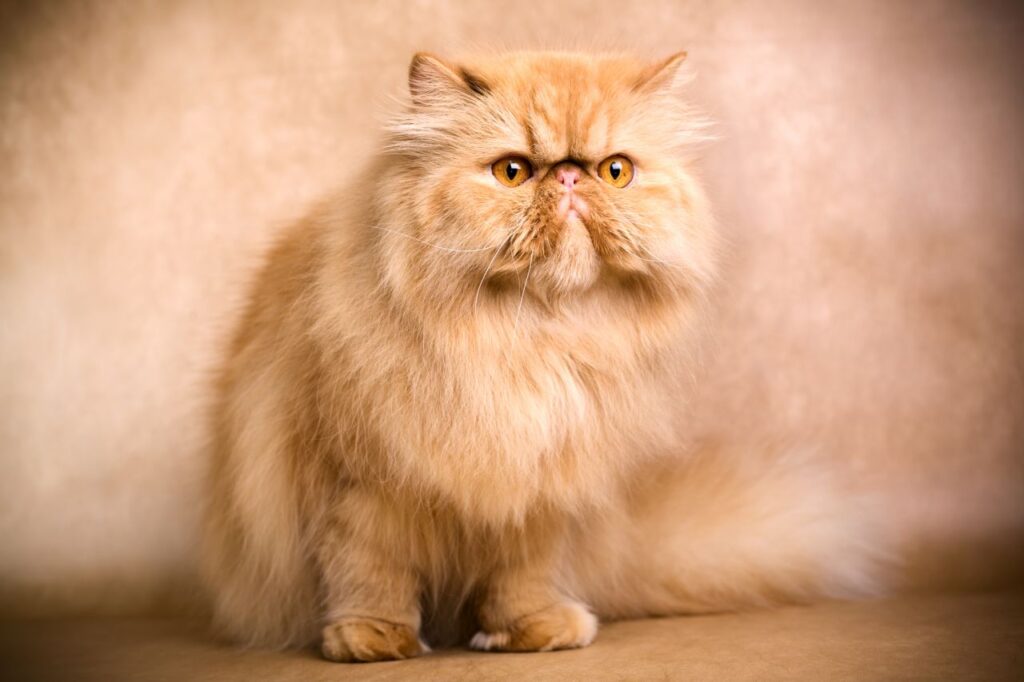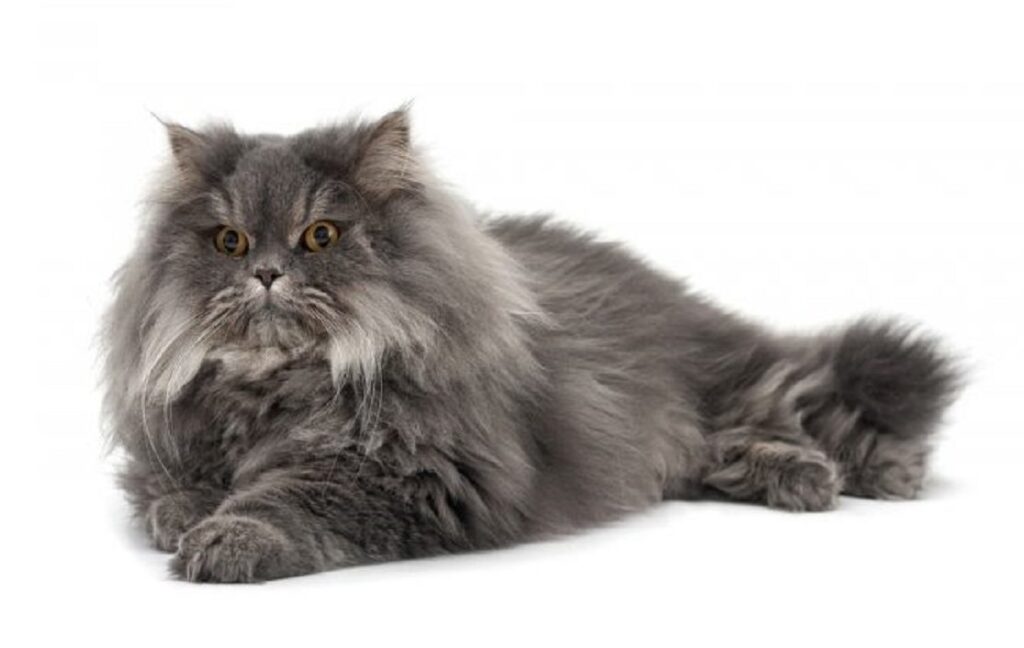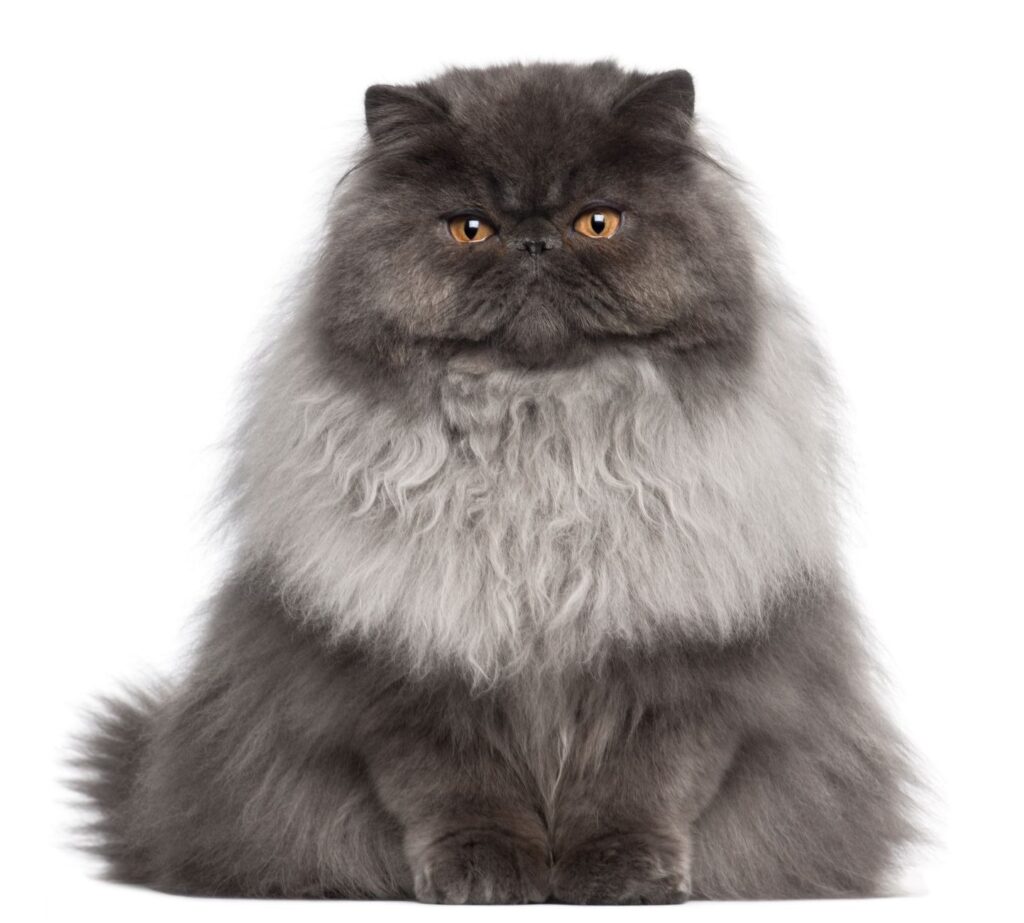The Persian cat is a creature of great elegance and beauty that usually stands out in the beauty competitions of these animals. It is recognized by its flattened nose, strong and stocky body, long and smooth coat of very different colors, but which requires daily brushing. It is considered the ideal pet for those who want a docile, tender and calm animal. To learn more about Persian Cats, we invite you to continue reading this article.

Persian Cats
The Persian cat is recognized as one of the most popular feline breeds on the planet, being considered the fourth most appreciated according to the Cat Fancier's Association. The Persian is a cat breed that is usually characterized by having a broad, flat face and a very profuse coat of various colors. They are often perceived as aristocratic animals (75% of registered pedigree cats are Persian).
It was in Italy that the first Persian cats brought from Persia (now Iran) arrived in the 1620s and their offspring were given different names. The present Persian lineage developed in the late 1800s in England and derives from the Turkish Angora cat. . To differentiate them we have to look at the appearance of their head, the shape of their body and the color that each particular individual exhibits. In the following paragraphs we will provide you with more details about the different types of existing Persian cats.
History
From a general perspective, it is not clear when long-haired cats made their first appearance, since there are no long-haired African wild cats (which are considered to be the ancestors of domestic cats). The XNUMXth-century nobility demanded long-haired cats, and the gene for long hair was introduced through hybridization with Pallas's cat.
Its first duly recorded ancestors were brought from Khorasan, Persia, to Italy in 1620 by Pietro della Valle, and those of the Angora cat (now Ankara) from Turkey to France, by Nicholas Claude Fabri de Peiresc at the same time. The Khorasan specimens were gray, while the Angora specimens were white. From France they soon passed to Great Britain. Long-haired felines from Afghanistan, Burma, China and Russia were also imported to Europe. Crossbreeding between these species was frequent, particularly between Angoras and Persians.
Features
They are usually characterized as being medium to large in size, with a compact, rounded head and a broad skull. His forehead is rounded and his cheekbones firm and prominent. Its small snout and thick, full chin. His eyes are huge, rounded, quite open and the further apart the better, with a very vivid and bright coloration. The location of its nose should be asymmetrical, but it is important that it is located at eye level and deep enough (flat nose) for a show cat.
Their ears are tiny and rounded and should be in a "V" position, uneven on the head. Their tips are covered with hairs that emerge from the inside out, making them go unnoticed but very beautiful as they blend in with the long fur on the back, legs and head. The body of this Persian feline is rounded and highly muscular, with a very stocky bone structure. The best body configuration of this breed is massive and is known as a "Corby body", standing out above its limbs that are tiny and thick.
It has a profuse, thick, long and soft-touch coat. Additionally, it is usual for it to release a lot of hair given its exuberance. The tail is woolly and rounded at the tip. Its tail is usually no longer than half its body (small tail). In this way, we can point out that Persian cats do not stand out for being slender but rather compact, rounded and stocky.
This breed can have very different colors. There are those of a single even color (solid), intense and without lighter shades, such as black, white, blue, chocolate, lilac, red and cream. They can also show varied colors (bicolors or with different variants between stripes and colors called Tabby, which is the drawing they exhibit on their fur, males can only have two colors, while females can have three for example (calicó = red, black, white).
Despite known cases of bicolor and tricolor males, these specimens turn out to be sterile. Himalayan specimens are recognized, which are usually distinguished by their blue color with dark tints that highlight their ears, tail, the ends of their legs and their faces, this is called (point) for example = red point.
Persian cats today have a solid body (corby), an upturned muzzle on a huge round head. Its profuse and copious coat is its most noticeable feature, which usually changes at certain times. For proper maintenance of the quality of their fur, it is of the utmost importance to brush them daily as good advice. These cats are friendly, they like to share with children. He is a lap cat.
It is quite appropriate to maintain the regularity of their baths, with special techniques for removing excess fat from the coat, as well as for the correct cleaning of the ears and face. To prevent the spread of fat, you should try not to comb their tail, since that is where they secrete the most fat. To remove it, at the time of bathing it is recommended to use dishwashing detergent since it degreases and is not harmful to the animal.
There are also the so-called Himalayan Persians, which are distinguished from the Persians in their coat. A Himalayan Persian feline has all the traits of a Persian but its coat is similar in color to that of the Siamese. A Himalayan exhibits the same color varieties as the Siamese, being able to be called according to the coloration of the distal parts (blue, chocolate, red, lilac, etc.). It is usually distinguished by the dark tints that stand out in its ears, tail, ends of their legs and their faces.
The Himalayan felines have blue eyes, the color point or colorpoint can be located on the ears as well as on the legs, back and tail and the rest of the fur is usually white or cream. The most frequent color points are: chocolate, lilac, cream, red, tortoiseshell (or tortieshell), black, blue and bicolor. This cat breed requires great care and dedication on the part of its owners. Its breeding is difficult, being its gestation period of about 64 days with litters of 1 to 6 kittens. These are usually weaned around three months.
Persian cats show a peaceful and homely character, as if they had never known the wild instincts of their feline relatives. They are often called couch tigers as they love to doze and laze. He is presumptuous by nature, he is of the cat breed with a gentle and affectionate temperament, affectionate nature, sympathizes with humans as well as with other animals.
Conditions
This cat species usually suffers from a pathology called polycystic kidney disease, also known as PKD (Poliquistic Kidney Disease). It is a genetic condition that affects its kidneys, giving rise to numerous tumors, which could later produce a kidney failure, so it is very important to make an early diagnosis.
Fluid-filled cysts often develop in one or both feline kidneys. Such cysts grow and destroy the healthy tissue that usually covers them, damaging the function of these organs and causing permanent kidney failure. As it is a genetic disease, ask your breeder to show you the negative certificates of your ancestors.
Special attention should be paid to the feeding of these felines, since after an operation they tend to be overweight, recognizing obesity in these animals as very serious.
Types of Persian Cats
Although new variants of the breed have come to be known, the Persian is one of the oldest cats in the world. A number of seven types of cats, grouped according to their coat patterns, are currently officially recognized by the Cat Fancier's Association.
Solid
We will start the list of Persians with those that are classified in the group of solid colors. These creatures usually show an even coat, from the root, and must not show marks or shadows, and can be white, black, blue, chocolate, lilac, red or cream. In this grouping the eyes are only copper colored. However, in the case of pristine white Persians, up to three eye colorations could be achieved: copper, deep blue and a mixture of both, since they could also present heterochromia.
Silver&Gold
In this grouping of types of Persian felines we get the greyish, gold and silver ones. They tend to be the ones that exhibit the lowest definition colors of all existing Persian cats. The color is completely white, with a slightly dark and variable tone on the face, legs, tail and body. The eyes of silver and gold specimens are usually green or greenish blue.
Smoke&Shaded
In this group of types of Persian cats we can see some felines that, in a resting position, appear to be solid in color. However, when moving the coat opens, and a kind of "smoke" can be noticed in the coat that can be of different colors, such as black, blue, cream, red, smoked tortoiseshell, smoked blue and smoked cream. This mantle variation emerges about six to eight weeks into existence. The eyes are usually coppery in color.
Tabby
Next on the list are Persian types classified as tabbies, which are known to be the most open-minded. We can get three models: the classic, the mackerel and the brindle. The most commonly recognized colors are silver, silver blue, red, chocolate, blue, cream, cameo, and cream cameo. Most of them have bright copper eyes, although the silver variety can also have hazel or green eyes.
particolor
Within the particolor type we get the “tortoise shell”, cream blue, “chocolate shell” and cream lilac Persian cats. Tortoiseshells are also known, which are black with spots scattered around the face. All of them have bright copper-colored eyes.
Bicolor
In the group of bicolor Persian cats we get the calico felines, bicolor, "smoke" and white or "tabby" and white. They exhibit a typical pattern on the head and legs, to which must be added up to two colored spots on the body. They usually mix black, blue, red, cream, chocolate and lilac colors with white. All have bright copper eyes, except for silver tabby Persians, which can also have green or hazel eyes.
Himalayan
We end our list with the Himalayan, possibly one of the most popular and appreciated varieties of Persian cats in the world. This mantle model can be exhibited in different colors: chocolate, grey, lilac, blue and red. However, these colors are the ones shown on the facial mask and on the legs, which mix with the different shades of the body, which range from white to beige.
These Persian felines were achieved based on the crossing of Persian and Siamese cats, in this way the coloration of the Siamese with the figure of the Persian was achieved, product of genetic selection. Despite this, it took years for them to be recognized by the different feline federations. Himalayan Siamese cats have vivid blue eyes.
How to take care of a Persian cat?
The attention that should be given to a Persian cat is varied and, as responsible owners, we must know it before adopting a feline of this breed. We will begin by commenting on the care of the coat of these specimens:
1.- The Persians are felines with long hair, which are also usually recognized for their devotion to daily grooming. However, those who value the possibility of adopting one of these specimens must be aware of the relevance of frequent brushing, since otherwise the animal may be exposed to hairballs accumulating in its stomach, which could cause various health problems.
2.- The bath seems not to be essential at first, however, those felines that were adopted in their socialization stage will enjoy enormously if we get them used to taking regular baths. This routine can be particularly positive to keep your coat in perfect condition and prevent knots and tangles.
3.- His aristocratic appearance suits his temperament. They are often quiet cats, who tend to enjoy a relaxed life in an apartment, as long as they are provided with plenty of environmental enrichment. Additionally, they form very solid ties with their tutors, choosing one or several members as "favorites".
4.- On the other hand, the presence before the veterinarian is obligatory. The expert will help us to correctly follow the feline's vaccination schedule and the deworming routine. It is convenient to make periodic visits every 6 or 12 months, with which we will be able to recognize any of the frequent pathologies in these animals early.
You may also be interested in these other articles:






